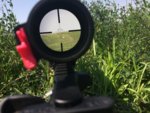Hmmm, I read some of his exploits - he was sub-200yds. The guy is a hunter, not a sniper-wannabe.
Pat Sinclair? You mean the guy who helped design the Bushnell LRHS, GAP 6.5 4S, and uses an S&B PMII 10x40mm scope?
To jump in on said dumpster fire, my take is this:
Hunting big game with a .223 is the equivalent of all the IGFA 4, 6 and 8 pound test line class records. Can you spool a TLD 25 up with 8 pound test and catch a marlin? Yes. It is certainly possible. Is it less ethical? Probably. The fish caught that way are fought for many times as long as those caught with reasonable tackle, which correlates directly to a lower post-release survival rate.
Can you kill an elk with 77 gr. SMKs? Probably. In the above analogy, it's more like the 14 pound test, probably. But, .308 is 30 pound. You'll lose twice as many fish (elk) with 14 (.223) as you do by using the right gear. The difference between hunting and fishing is significant, too- if you're making the conscious decision to take an animal's life, I say you owe it to that animal to be as respectful and humane as you can be in that process.
My $0.02, worth what ya paid for it.
So you’ve shot and lost elk with a 223?
No, it’s nothing like your analogy at all, and no one has said anything about using an SMK on elk.
So tell me what the ACTUAL difference in tissue damage is between whatever “30cal” you use and the 77gr TMK?
And this is the problem - lots of never-recovered rotting Elk carcasses as guys "learn" what others have taught. There are reasons why there are recommended minimums for each class of game animal.
For me, I would be afraid that at 400yds the 77gr TMK will either expand and penetrate 5-8" or it will pencil in. Neither case will do enough damage to vitals to put an Elk down fast.
Deer go maybe 200lbs. Elk go easily 3x that.
People had no idea, and this thread shows that most people still have no idea what ACTUAL tissue damage is caused by bullets.
“Recommended minimums” are generally not based on reality, but folk lore, gun shop myths, and ol’ Elmer Keith. The fact that you would “
be afraid that at 400yds the 77gr TMK will either expand and penetrate 5-8" or it will pencil in” shows that you have no knowledge of that bullet in the least. It didn’t exist 10 years ago. There is no recommended minimum for it, because no one knows.
Straight question- is a 180gr Barnes TSX from a 308 win at 400 yards enough for elk?
So are you suggesting that the .223 is the largest caliber you can use to purposefully shoot and learn?
There must be some reason you have to choose it over even say, a 6.5 Grendel or .243
The real question is- is there a 22 cal centerfire bullet that can penetrate deep enough and create enough tissue damage to reliably kill elk? If yes, then why wouldn’t someone use it?
Why use smaller calibers/cartridges? Easy- hit rates. Every single person alive shoots a 223 better than a 243 in the same gun. Every person shoots a 243 better than a 308, and 308 better than a 338 mag. Full stop.
I use a 223 as the main deer rifle because it’s already causing more damage than I want inside of 400 yards. What would I gain by going to a bigger round? I have killed hundreds of big game animals with magnums. We all choose bullets that tone down those bigger rounds to an accrepable level. If you maximize 308 and bigger rounds for actual damage it’s quite frankly disgusting. Like throw out half the animal.
You want to see what a 30cal maximized does, ok-

That’s a full sized deer. That exit wound is 9.5 inches wide, 18 inches long. Yes. That’s what I want.
How about this-
220lb weighed buck-

It can get worse than that as well. So we take bigger rounds and use bullets that are designed to minimize tissue damage because we don’t want the above. That’s is equivalent to buying a V8 and then because it’s too fast, start yanking spark plugs out to tone it down. NO ONE does that. Why not drop down in calibers until when maximized the damage/effects are what we want? Then we can also gain less recoil, weight, cost, muzzle blast, length, while having more fun and the ability to spot your own impacts. That’s leads to higher hit rates, and more success.
Nope. Completely different logic.
What I hear the OP saying here is that he chooses the .223 because of it's practicality to shoot and learn. What I'm asking is if that's the largest caliber they feel they can shoot and learn with.
Still trying to understand the logic behind the choice here.
See above. You are taking your bigger calibers/cartridges and yanking spark plugs without even knowing it. What the OP is doing is moving down and MAXIMIZING the smaller cartridge to get to the same spot. He’s just doing it with less recoil, muzzle blast, cost, and gaining more rounds, fun, and the ability to spot his own impacts.



